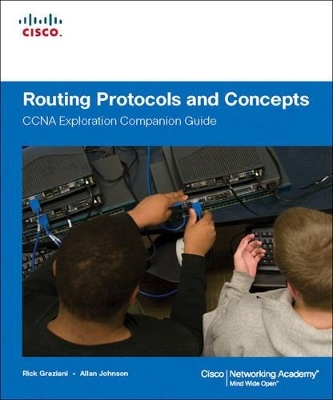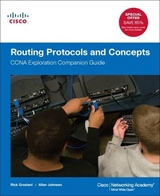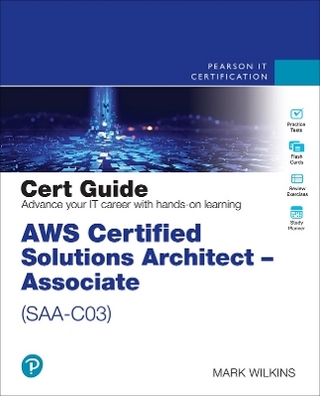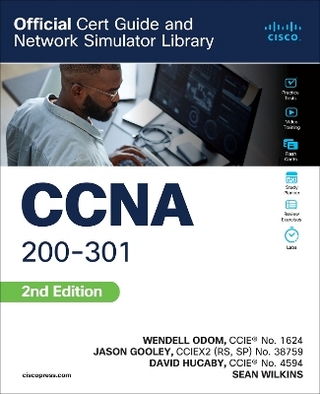
Routing Protocols and Concepts, CCNA Exploration Companion Guide
Cisco Press
978-1-58713-206-3 (ISBN)
- Titel erscheint in neuer Auflage
- Artikel merken
CCNA Exploration Companion Guide
Routing Protocols and Concepts, CCNA Exploration Companion Guide is the official supplemental textbook for the Routing Protocols and Concepts course in the Cisco Networking Academy® CCNA® Exploration curriculum version 4. This course describes the architecture, components, and operation of routers, and explains the principles of routing and the primary routing protocols. The Companion Guide, written and edited by Networking Academy instructors, is designed as a portable desk reference to use anytime, anywhere. The book’s features reinforce the material in the course to help you focus on important concepts and organize your study time for exams.
New and improved features help you study and succeed in this course:
Chapter objectives—Review core concepts by answering the focus questions listed at the beginning of each chapter.
Key terms—Refer to the updated lists of networking vocabulary introduced and turn to the highlighted terms in context in each chapter.
Glossary—Consult the comprehensive glossary with more than 150 terms.
Check Your Understanding questions and answer key—Evaluate your readiness with the updated end-of-chapter questions that match the style of questions you see on the online course quizzes. The answer key explains each answer.
Challenge questions and activities—Strive to ace more challenging review questions and activities designed to prepare you for the complex styles of questions you might see on the CCNA exam. The answer key explains each answer.
Rick Graziani has been a computer science and networking instructor at Cabrillo College since 1994.
Allan Johnson works full time developing curriculum for Cisco Networking Academy. Allan also is a part-time instructor at Del Mar College in Corpus Christi, Texas.
How To—Look for this icon to study the steps you need to learn to perform certain tasks.
Packet Tracer Activities— Explore networking concepts in activities interspersed throughout some chapters using
Packet Tracer v4.1 developed by Cisco®. The files for these activities are on the accompanying CD-ROM.
Also available for the Routing Protocols and Concepts Course:
Routing Protocols and Concepts
CCNA Exploration
Labs and Study Guide
ISBN-10: 1-58713-204-4
ISBN-13: 978-1-58713-204-9
Companion CD-ROM
The CD-ROM provides many useful tools and information to support your education:
Packet Tracer Activity exercise files v4.1
A Guide to Using a Networker’s Journal booklet
Taking Notes: a .txt file of the chapter objectives
More IT Career Information
Tips on Lifelong Learning in Networking
This book is part of the Cisco Networking Academy Series from Cisco Press®. The products in this series support and complement the Cisco Networking Academy online curriculum.
Rick Graziani teaches computer science and computer networking courses at Cabrillo College in Aptos, California. Rick has worked and taught in the computer networking and information technology field for almost 30 years. Prior to teaching, Rick worked in IT for various companies including Santa Cruz Operation, Tandem Computers, and Lockheed Missiles and Space Corporation. He holds an M.A. in computer science and systems theory from California State University Monterey Bay. Rick also does consulting work for Cisco and other companies. When Rick is not working, he is most likely surfing. Rick is an avid surfer who enjoys longboarding at his favorite Santa Cruz surf breaks. Allan Johnson entered the academic world in 1999 after 10 years as a business owner/operator to dedicate his efforts to his passion for teaching. He holds both an M.B.A. and an M.Ed. in occupational training and development. He is an information technology instructor at Del Mar College in Corpus Christi, Texas. In 2003, Allan began to commit much of his time and energy to the CCNA Instructional Support Team, providing services to Networking Academy instructors worldwide and creating training materials. He now works full time for the Academy in Learning Systems Development.
Introduction
Chapter 1 Introduction to Routing and Packet Forwarding
Objectives
Key Terms
Inside the Router
Routers Are Computers
Routers Are at the Network Center
Routers Determine the Best Path
Router CPU and Memory
CPU
RAM
ROM
Flash Memory
NVRAM
Internetwork Operating System (IOS)
Router Bootup Process
Bootup Process
Command-Line Interface
Verifying Router Bootup Process
IOS Version
ROM Bootstrap Program
Location of IOS
CPU and Amount of RAM
Interfaces
Amount of NVRAM
Amount of Flash
Configuration Register
Router Ports and Interfaces
Management Ports
Router Interfaces
Interfaces Belong to Different Networks
Example of Router Interfaces
Routers and the Network Layer
Routing Is Forwarding Packets
Routers Operate at Layers 1, 2, and 3
CLI Configuration and Addressing
Implementing Basic Addressing Schemes
Populating an Address Table
Basic Router Configuration
Host Name and Passwords
Configuring a Banner
Router Interface Configuration
Each Interface Belongs to a Different Network
Verifying Basic Router Configuration
Building the Routing Table
Introducing the Routing Table
show ip route Command
Directly Connected Networks
Static Routing
When to Use Static Routes
Dynamic Routing
Automatic Network Discovery
Maintaining Routing Tables
IP Routing Protocols
Routing Table Principles
Asymmetric Routing
Path Determination and Switching Functions
Packet Fields and Frame Fields
Internet Protocol (IP) Packet Format
MAC Layer Frame Format
Best Path and Metrics
Best Path
Comparing Hop Count and Bandwidth Metrics
Equal-Cost Load Balancing
Equal-Cost Paths Versus Unequal-Cost Paths
Path Determination
Switching Function
Path Determination and Switching Function Details
Path Determination and Switching Function Summary
Summary
Labs
Check Your Understanding
Challenge Questions and Activities
To Learn More
End Notes
Chapter 2 Static Routing
Objectives
Key Terms
Routers and the Network
Role of the Router
Introducing the Topology
Examining the Connections of the Router
Router Connections
Serial Connectors
Ethernet Connectors
Router Configuration Review
Examining Router Interfaces
Interfaces and Their Statuses
Additional Commands for Examining Interface Status
Configuring an Ethernet Interface
Configuring an Ethernet Interface
Unsolicited Messages from IOS
Reading the Routing Table
Routers Usually Store Network Addresses
Verifying Ethernet Addresses
Commands to Verify Interface Configuration
Ethernet Interfaces Participate in ARP
Configuring a Serial Interface
Examining Serial Interfaces
Physically Connecting a WAN Interface
Configuring Serial Links in a Lab Environment
Verifying the Serial Interface Configuration
Exploring Directly Connected Networks
Verifying Changes to the Routing Table
Routing Table Concepts
Observing Routes as They Are Added to the Routing Table
Changing an IP Address
Devices on Directly Connected Networks
Accessing Devices on Directly Connected Networks
Pings from R2 to 172.16.3.1
Pings from R2 to 192.168.1.1
Cisco Discovery Protocol (CDP)
Network Discovery with CDP
Layer 3 Neighbors
Layer 2 Neighbors
CDP Operation
Using CDP for Network Discovery
CDP show Commands
Disabling CDP
Static Routes with “Next-Hop” Addresses
Purpose and Command Syntax of the ip route Command
ip route Command
Configuring Static Routes
Verifying the Static Route
Configuring Routes to Two More Remote Networks
Routing Table Principles and Static Routes
Applying the Principles
Resolving to an Exit Interface with a Recursive Route Lookup
Exit Interface Is Down
Static Routes with Exit Interfaces
Configuring a Static Route with an Exit Interface
Static Route and an Exit Interface
Static Routes and Point-to-Point Networks
Modifying Static Routes
Verifying the Static Route Configuration
Verifying Static Route Changes
Static Routes with Ethernet Interfaces
Ethernet Interfaces and ARP
Sending an ARP Request
Static Routes and Ethernet Exit Interfaces
Advantages of Using an Exit Interface with Static Routes
Summary and Default Static Routes
Summary Static Routes
Summarizing Routes to Reduce the Size of the Routing Table
Route Summarization
Calculating a Summary Route
Configuring a Summary Route
Default Static Route
Most Specific Match
Configuring a Default Static Route
Verifying a Default Static Route
Managing and Troubleshooting Static Routes
Static Routes and Packet Forwarding
Static Routes and Packet Forwarding
Troubleshooting a Missing Route
Troubleshooting a Missing Route
Solving the Missing Route
Summary
Labs
Check Your Understanding
Challenge Questions and Activities
To Learn More
Floating Static Routes
Discard Route
Further Reading on Static Routing
End Notes
Chapter 3 Introduction to Dynamic Routing Protocols
Objectives
Key Terms
Introduction to Dynamic Routing Protocols
Perspective and Background
Evolution of Dynamic Routing Protocols
Role of Dynamic Routing Protocol
Network Discovery and Routing Table Maintenance
Purpose of Dynamic Routing Protocols
Dynamic Routing Protocol Operation
Dynamic Routing Protocol Advantages
Static Routing Usage, Advantages, and Disadvantages
Dynamic Routing Advantages and Disadvantages
Classifying Dynamic Routing Protocols
IGP and EGP
Distance Vector and Link-State Routing Protocols
Distance Vector Routing Protocol Operation
Link-State Protocol Operation
Classful and Classless Routing Protocols
Classful Routing Protocols
Classless Routing Protocols
Dynamic Routing Protocols and Convergence
Metrics
Purpose of a Metric
Metrics and Routing Protocols
Metric Parameters
Metric Field in the Routing Table
Load Balancing
Administrative Distance
Purpose of Administrative Distance
Multiple Routing Sources
Purpose of Administrative Distance
Dynamic Routing Protocols and Administrative Distance
Static Routes and Administrative Distance
Directly Connected Networks and Administrative Distance
Summary
Activities and Labs
Check Your Understanding
Challenge Questions and Activities
To Learn More
Chapter 4 Distance Vector Routing Protocols
Objectives
Key Terms
Introduction to Distance Vector Routing Protocols
Distance Vector Technology
Meaning of Distance Vector
Operation of Distance Vector Routing Protocols
Routing Protocol Algorithms
Routing Protocol Characteristics
Comparing Routing Protocol Features
Network Discovery
Cold Start
Initial Exchange of Routing Information
Exchange of Routing Information
Convergence
Routing Table Maintenance
Periodic Updates
Maintaining the Routing Table
RIP Timers
Bounded Updates
Triggered Updates
Random Jitter
Routing Loops
Defining a Routing Loop
Implications of Routing Loops
Count-to-Infinity Condition
Preventing Routing Loops by Setting a Maximum Metric Value
Preventing Routing Loops with Hold-Down Timers
Preventing Routing Loops with the Split Horizon Rule
Route Poisoning
Split Horizon with Poison Reverse
Preventing Routing Loops with IP and TTL
Distance Vector Routing Protocols Today
RIP and EIGRP
RIP
EIGRP
Summary
Activities and Labs
Check Your Understanding
Challenge Questions and Activities
To Learn More
Chapter 5 RIP Version 1
Objectives
Key Terms
RIPv1: Distance Vector, Classful Routing Protocol
Background and Perspective
RIPv1 Characteristics and Message Format
RIP Characteristics
RIP Message Format: RIP Header
RIP Message Format: Route Entry
Why Are So Many Fields Set to Zero?
RIP Operation
RIP Request/Response Process
IP Address Classes and Classful Routing
Administrative Distance
Basic RIPv1 Configuration
RIPv1 Scenario A
Enabling RIP: router rip Command
Specifying Networks
Verification and Troubleshooting
Verifying RIP: show ip route Command
Verifying RIP: show ip protocols Command
Verifying RIP: debug ip rip Command
Passive Interfaces
Unnecessary RIP Updates Impact Network
Stopping Unnecessary RIP Updates
Automatic Summarization
Modified Topology: Scenario B
Boundary Routers and Automatic Summarization
Processing RIP Updates
Rules for Processing RIPv1 Updates
Example of RIPv1 Processing Updates
Sending RIP Updates: Using debug to View Automatic
Summarization
Advantages and Disadvantages of Automatic Summarization
Advantages of Automatic Summarization
Disadvantage of Automatic Summarization
Discontiguous Topologies Do Not Converge with RIPv1
Default Route and RIPv1
Modified Topology: Scenario C
Propagating the Default Route in RIPv1
Summary
Activities and Labs
Check Your Understanding
Challenge Questions and Activities
To Learn More
Chapter 6 VLSM and CIDR
Objectives
Key Terms
Classful and Classless Addressing
Classful IP Addressing
High-Order Bits
IPv4 Classful Addressing Structure
Classful Routing Protocol
Classless IP Addressing
Moving Toward Classless Addressing
CIDR and Route Summarization
Classless Routing Protocol
VLSM
VLSM in Action
VLSM and IP Addresses
CIDR
Route Summarization
Calculating Route Summarization
Summary
Activities and Labs
Check Your Understanding
Challenge Questions and Activities
To Learn More
Chapter 7 RIPv2
Objectives
Key Terms
RIPv1 Limitations
Summary Route
VLSM
RFC 1918 Private Addresses
Cisco Example IP Addresses
Loopback Interfaces
RIPv1 Topology Limitations
Static Routes and Null Interfaces
Route Redistribution
Verifying and Testing Connectivity
RIPv1: Discontiguous Networks
Examining the Routing Tables
How Classful Routing Protocols Determine Subnet Masks
RIPv1: No VLSM Support
RIPv1: No CIDR Support
192.168.0.0/16 Static Route
Configuring RIPv2
Enabling and Verifying RIPv2
Auto-Summary and RIPv2
Disabling Auto-Summary in RIPv2
Verifying RIPv2 Updates
VLSM and CIDR
RIPv2 and VLSM
RIPv2 and CIDR
Verifying and Troubleshooting RIPv2
Verification and Troubleshooting Commands
show ip route Command
show ip interface brief Command
show ip protocols Command
debug ip rip Command
ping Command
show running-config Command
Common RIPv2 Issues
Authentication
Summary
Activities and Labs
Check Your Understanding
Challenge Questions and Activities
To Learn More
Chapter 8 The Routing Table: A Closer Look
Objectives
Key Terms
The Routing Table Structure
Lab Topology
Routing Table Entries
Level 1 Routes
Parent and Child Routes: Classful Networks
Level 1 Parent Route
Level 2 Child Route
Parent and Child Routes: Classless Networks
Routing Table Lookup Process
Steps in the Route Table Lookup Process
The Route Lookup Process
Longest Match: Level 1 Network Routes
Longest Match
Example: Level 1 Ultimate Route
Longest Match: Level 1 Parent and Level 2 Child Routes
Example: Level 1 Parent Route and Level 2 Child Routes
Example: Route Lookup Process with VLSM
Routing Behavior
Classful and Classless Routing Behavior
Topology Changes
Classful Routing Behavior: no ip classless
Classful Routing Behavior: Search Process
Example: R2 Operating with Classful Routing Behavior
Classless Routing Behavior: ip classless
The Route Lookup Process
Classless Routing Behavior: Search Process
Example: R2 Operating with Classless Routing Behavior
Classful Route on R3
Classful vs. Classless Routing Behavior in the Real World
Summary
Activities and Labs
Check Your Understanding
Challenge Questions and Activities
To Learn More
End Notes
Chapter 9 EIGRP
Objectives
Key Terms
Introduction to EIGRP
EIGRP: An Enhanced Distance Vector Routing Protocol
Roots of EIGRP: IGRP
The Algorithm
Path Determination
Convergence
EIGRP Message Format
Protocol-Dependent Modules
RTP and EIGRP Packet Types
EIGRP Packet Types
Hello Protocol
EIGRP Bounded Updates
DUAL: An Introduction
Administrative Distance
Authentication
Basic EIGRP Configuration
EIGRP Network Topology
Autonomous Systems and Process IDs
Autonomous System
Process ID
The router eigrp Command
The network Command
The network Command with a Wildcard Mask
Verifying EIGRP
Examining the Routing Table
Introducing the Null0 Summary Route
R3 Routing Table
EIGRP Metric Calculation
EIGRP Composite Metric and the K Values
The Composite Metric
Verifying the K Values
EIGRP Metrics
Examining the Metric Values
Bandwidth
Delay
Reliability
Load
Using the bandwidth Command
Calculating the EIGRP Metric
Bandwidth
Delay
Adding Bandwidth and Delay
DUAL
DUAL Concepts
Successor and Feasible Distance
Feasible Successors, Feasibility Condition, and Reported Distance
Topology Table: Successor and Feasible Successor
Topology Table: No Feasible Successor
Finite State Machine
DUAL FSM
No Feasible Successor
More EIGRP Configurations
The Null0 Summary Route
Disabling Automatic Summarization
Manual Summarization
Determining the Summary EIGRP Route
Configure EIGRP Manual Summarization
EIGRP Default Route
Fine-Tuning EIGRP
EIGRP Bandwidth Utilization
Configuring Hello Intervals and Hold Times
Summary
Activities and Labs
Check Your Understanding
Challenge Questions and Activities
To Learn More
Chapter 10 Link-State Routing Protocols
Objectives
Key Terms
Link-State Routing
Link-State Routing Protocols
Introduction to the SPF Algorithm
Link-State Routing Process
Step 1: Learning About Directly Connected Networks
Links
Link States
Step 2: Sending Hello Packets to Neighbors
Step 3: Building the Link-State Packet
Step 4: Flooding Link-State Packets to Neighbors
Step 5: Constructing a Link-State Database
Shortest Path First (SPF) Tree
Building the SPF Tree
Determining the Shortest Path
Generating a Routing Table from the SPF Tree
Implementing Link-State Routing Protocols
Advantages of a Link-State Routing Protocol
Builds a Topological Map
Fast Convergence
Event-Driven Updates
Hierarchical Design
Requirements of a Link-State Routing Protocol
Memory Requirements
Processing Requirements
Bandwidth Requirements
Comparison of Link-State Routing Protocols
Summary
Activities and Labs
Check Your Understanding
Challenge Questions and Activities
To Learn More
Chapter 11 OSPF
Objectives
Key Terms
Introduction to OSPF
Background of OSPF
OSPF Message Encapsulation
OSPF Packet Types
Hello Protocol
Neighbor Establishment
OSPF Hello and Dead Intervals
Electing a DR and BDR
OSPF LSUs
OSPF Algorithm
Administrative Distance
Authentication
Basic OSPF Configuration
Lab Topology
The router ospf Command
The network Command
OSPF Router ID
Determining the Router ID
Highest Active IP Address
Verifying the Router ID
Loopback Address
OSPF router-id Command
Modifying the Router ID
Duplicate Router IDs
Verifying OSPF
Examining the Routing Table
The OSPF Metric
OSPF Metric
Reference Bandwidth
OSPF Accumulates Cost
Default Bandwidth on Serial Interfaces
Modifying the Cost of the Link
The bandwidth Command
The ip ospf cost Command
The bandwidth Command vs. the ip ospf cost Command
OSPF and Multiaccess Networks
Challenges in Multiaccess Networks
Multiple Adjacencies
Flooding of LSAs
Solution: Designated Router
DR/BDR Election Process
Topology Change
DR/BDR Election
Timing of DR/BDR Election
OSPF Interface Priority
More OSPF Configuration
Redistributing an OSPF Default Route
Topology
Fine-Tuning OSPF
Reference Bandwidth
Modifying OSPF Intervals
Summary
Activities and Labs
Check Your Understanding
Challenge Questions and Activities
To Learn More
Appendix Check Your Understanding and Challenge Questions Answer Key
Glossary of Key Terms
Index
1587132060 TOC 11/9/2007
| Erscheint lt. Verlag | 17.12.2007 |
|---|---|
| Reihe/Serie | Cisco Networking Academy - Mind Wide Open |
| Verlagsort | Indianapolis |
| Sprache | englisch |
| Maße | 242 x 209 mm |
| Gewicht | 1348 g |
| Themenwelt | Mathematik / Informatik ► Informatik ► Betriebssysteme / Server |
| Informatik ► Weitere Themen ► Zertifizierung | |
| ISBN-10 | 1-58713-206-0 / 1587132060 |
| ISBN-13 | 978-1-58713-206-3 / 9781587132063 |
| Zustand | Neuware |
| Haben Sie eine Frage zum Produkt? |
aus dem Bereich



